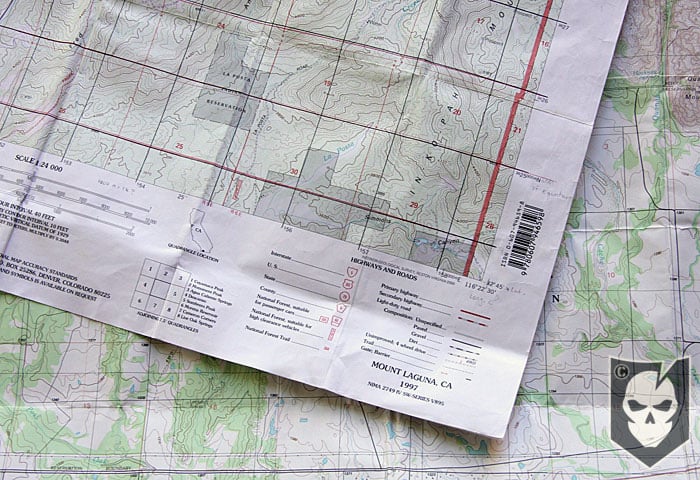In our last article on Land Navigation, Intro to Map Terminology, we introduced you to our LandNav series and went over the most common terms that get thrown around when dealing with maps.
Today we’ll be addressing what all those things in the margins of your map mean and how to best use them to your advantage when navigating.
The margins of a topographic map are rich with information. For the LandNav 101 series, we are going to be operating strictly against USGS maps. While other cartographic entities may vary their margin layout, most will contain all of the details covered herein.
Area and Scale
Measuring the distance on a two-dimensional printed map only estimates the distance; hence the reference to “as the crow flies.” This is because the topography of the environment isn’t considered; we live in a three-dimensional world. There is a difference in distance between a measurement on a map at the ocean’s edge versus a measurement across a mountainous landscape with perpetual ascents and descents. Remember, the focus of the series is on basic terrestrial navigation using a map and compass–so we aren’t going to talk about modern electronics that have the ability to compensate for these differences, that’s a future series.
Contour Intervals and Quadrangles
There are two other important pieces of information near the scale bar before we move on to the other information in the margins. First, the elevation model is based on datum from a 1929 survey. This is critical (think of Mount Saint Helens) would elevation data be useful from 1929? Likely not, since the mountain blew its top the elevations in the area have changed dramatically. The second useful bit of data is a friendly reminder of how to convert feet to meters, multiply by 0.3048.
Legends and Declination
Moving still further right along the bottom margin of the Hunstville quad is a simple legend, or table of symbols found on the map. Unfortunately, this is rarely an all-inclusive legend. I printed and carry the USGS Topographic Map Symbols reference behind my map in my map case. Carrying an additional two sheets of paper in my load is negligible, and the ability to quickly reference rarely seen contour symbols, boundaries, coastal features, etc. is nice when you’re on an extended trip through the backcountry.
Magnetic declination takes into consideration that the Earth’s poles are constantly shifting. I’m neither a geophysicist, nor did I spend the night at a Holiday Inn- so I’m not going down this rabbit hole any further! Suffice to say, knowing the current magnetic declination for the area you’re heading into is particularly important- your compass is going to point to magnetic north, not true north. If the map was printed years ago, the amount of magnetic shift could be very significant.
It then asks for a date, so if you are planning your trip for next summer, you can predict the declination for that point in time. In the example, we see that the Huntsville quad declination for 26 September 2010 is 3 ° 20′ E, changing by 0 ° 7′ W per year.
Declination Apps
- Launch Safari and search from NOAA Declination Calculator and select the correct www.ngdc.noaa.gov calculator search result to display the page
- Click the + button to create a bookmark
- Choose Add to Home Screen
- Enter a name, e.g. Mag Decl
There are also a few apps in the AppStore that provide you with your current declination based on your current GPS location or searched location, but we haven’t tested these in depth yet. Just search “declination” in the Apple AppStore to get a look at these.
Notes
Everyone reads the margins of a map to figure out if the map contains the right information for the area of interest. Our next article will shift from the margins to the data found on the map itself. We’ll be discussing both map colors and terrain feature identification.
The LandNav 101 series is using the Sam Houston National Forest as the training grounds for most of its cartographic adventures. If you’d like to download a PDF of the referenced topo map, it is the Huntsville 7.5 x 7.5 1997 map. It has an alternate ID of TTX1823, ISBN 978-0-607-93473-1. A printed version can be purchased from the USGS Store for $8.
